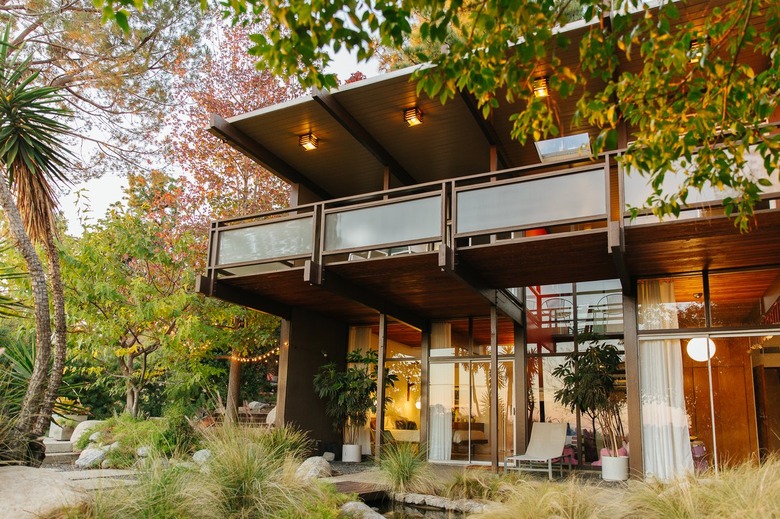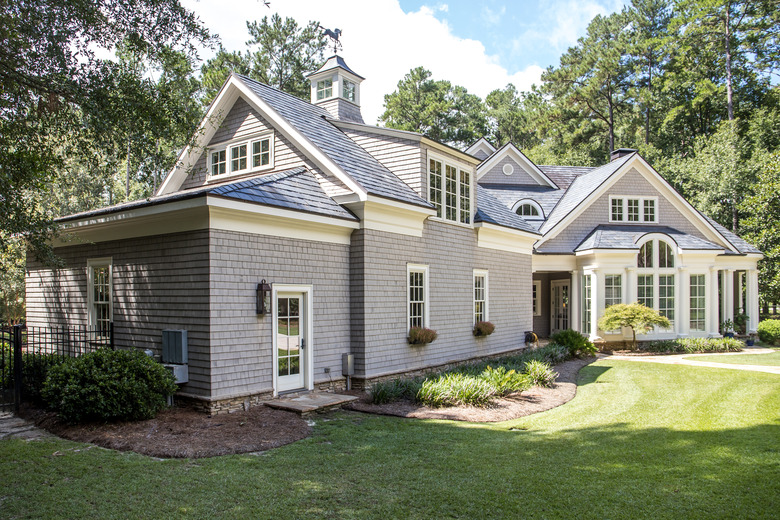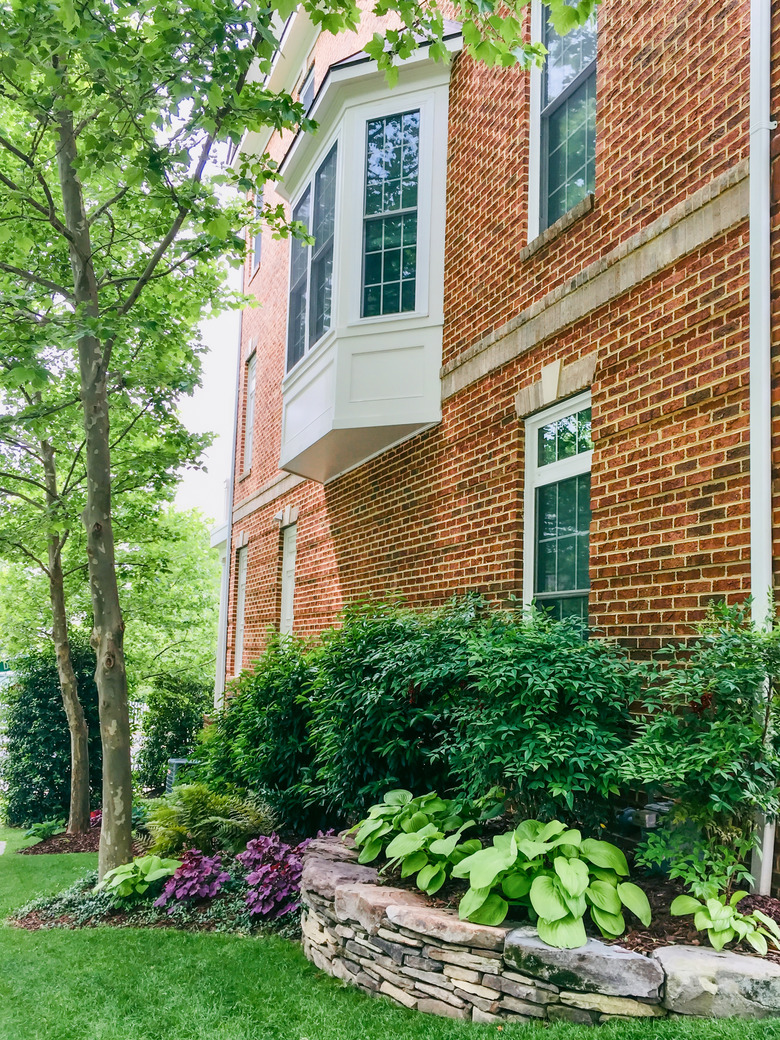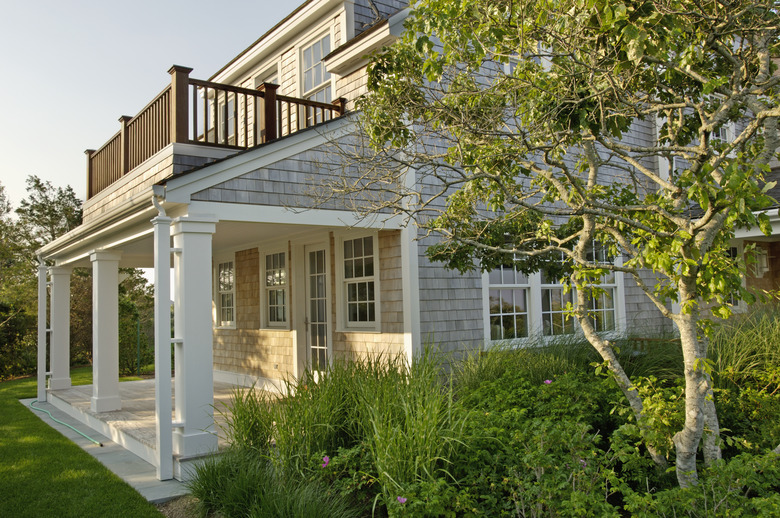Side Yard Landscaping Tips
We may receive a commission on purchases made from links.
Between striving to make a home's front yard a showcase and the effort to turn the backyard into a family oasis, it's easy to overlook the possibilities offered by the side yard. Depending on the overall size of your property and the orientation of the house, the side yard can be as small as a strip of grass or sidewalk, or it can be an expansive space that is just waiting for landscaping ideas to transform it. Most often, side yards are problematic spaces that are much longer than they are wide, with function and design challenges not found in front yards and backyards.
The side yard doesn't need to be a boring no-man's land where there is only grass to mow or a sidewalk for wheeling out the trash cans. With a rudimentary understanding of classic landscape design concepts and an eye to the special problems of a side yard, a DIYer can turn the side yard into a place that's both functional and attractive.
Landscape Design Principles
Landscape Design Principles
Landscape professionals generally use a well-known set of principles to guide their design decisions when planning a landscape, and DIYers can apply the same principles when designing their own landscapes. Side yards can pose some special challenges, but a good place to start is by applying classic design principles.
Many different landscape designers and real estate experts advise homeowners to use eight classic landscape design concepts:
- Unity
- Balance
- Transition
- Proportion
- Rhythm
- Focal point
- Repetition
- Simplicity
While these principles can seem confusing at first, they are actually fairly easy to apply, and keeping them in mind will make your side yard much more successful.
How to Create Unity in Your Side Yard
How to Create Unity in Your Side Yard
Unity as a design principle means that the elements of both the hardscape (the structural elements) and the softscape (the plants) are chosen so they work together functionally and aesthetically. For example, if the home is constructed of wood-look siding, unity is enhanced if you use a wood for the fencing and a deck. A brick or stone house might call for different landscape materials to achieve unity. Unity is also enhanced if you use plants that are native to your area rather than exotic plants (plus, they'll be a lot easier to grow and manage).
Unity can be even more important in the confined spaces of a side yard, where you will see all elements up close. Small spaces do not lend themselves to enormous diversity of materials, colors, building materials and plant species.
How to Achieve Balance in Your Side Yard
How to Achieve Balance in Your Side Yard
Balance refers to making sure that a space maintains an equilibrium of visual attraction. This doesn't mean that the landscape needs to be perfectly symmetrical but that the visual "weight" should be balanced from side to side. For example, a narrow side yard with a pathway will look balanced if weighty foundation shrubs are paired with weighty vines covering the fence opposite the foundation.
Balance is especially important in a side yard, where you may see the entirety of the yard in one glance. Achieving balance in the side yard can be as simple as ensuring the gates match on either side of the yard (or with the surrounding fence). If your side yard includes some kind of pathway (it should), then placing it in the center will help the landscape feel balanced.
Working With Transition in a Side Yard
Working With Transition in a Side Yard
The principle of transition refers to achieving a gradual, visually pleasing flow between elements of the landscape. This can involve transitions among colors, shapes, textures and sizes. This principle can be hard for a DIYer to grasp, but the idea is to avoid any abrupt visual shifts.
In a classic example, in a side yard bisected by a pathway lined with garden beds, the plants should be arranged with a gradual transition between low ground-cover plants edging the path and the taller upright plants or shrubs at the back of the planting beds. In a side yard, transition is something quite literal since the side yard itself forms the transition between the front yard and the backyard.
Both the plants and features of the side yard can be chosen so that there is a gradual transition between the look of the front yard and the look of the backyard. For example, side yard gardens might gradually transition from the formal perennials dominating the front yard to the brightly colored annuals that dominate the backyard.
Side Yard Proportion
Side Yard Proportion
Proportion as a design principle means considering the relative size and visual weight of elements as they work together in the landscape. A small ranch-style rambler calls for a smallish garden shed or foundation shrubs whereas a tall, peaked Tudor-style home calls for tall columnar foundation shrubs.
In the small space of a side yard, make sure the elements fit the size of the space and are consistent with one another. Avoid mismatches, such as a huge shrub or weighty trellis against the side of a one-story cottage-style home.
How to Create Rhythm in a Side Yard
How to Create Rhythm in a Side Yard
The sense of motion created by the selection and arrangement of elements is known as rhythm. The design should lead the eye through the landscape, manipulating the speed at which you view the yard or move through it. In a side yard, visual rhythm might be accomplished by a sequence of mound-shaped shrubs that gradually "crescendo" in size along the traffic flow, or a long, narrow side yard can be punctuated with attractive specimens that make you slow down and pause.
Rather than a straight route through the side yard, a pathway can manipulate rhythm by wandering slightly to the left and right. Rhythm can also be controlled by adding a small sitting area or focal point that encourages you to either slow down to relax or speed up with excitement. A small accent fountain with running water can literally add music to the rhythm through the sound of trickling water.
How to Establish a Focal Point in a Side Yard
How to Establish a Focal Point in a Side Yard
Any good landscape space should have at least one focal point that draws the eye and provides an element of mild surprise and delight. This can be a flowering shrub, a small statue or a fountain or ornamental birdbath. Side yards are relatively small spaces compared to the entire landscape, so this accent should be fairly small. Even an ornamental gate at one end of the pathway through the side yard can serve as the focal point. If the side yard is big enough, a small but decorative garden shed might serve as the focal point.
In a side yard, the focal point should be chosen with unity and other design principles in mind. For example, in a side yard that is intended as an ornamental space, adding a sculpted birdbath will create unity with the other elements. In a utilitarian side yard, on the other hand, the focal point might be a decorative rain barrel.
Achieving Repetition in a Side Yard
Achieving Repetition in a Side Yard
Repetition as a design principle is closely related to rhythm, but here it refers to the use of identical elements within the landscape. For example, a yard with planting beds can be punctuated with flowers that have the same bloom color or with small shrubs of the same species. Repetition executed with careful spacing enhances rhythm.
In a side yard, repetition can sometimes be effectively achieved with a boundary fence that has a repeating geometric pattern or with a flagstone walkway using stones of the same size and the same spacing. Using a limited number of plant species but using them frequently is a way to achieve repetition in a small side yard.
Designing With Simplicity in a Side Yard
Designing With Simplicity in a Side Yard
A good landscape always has an elegant simplicity, providing enough variety to make things interesting but not so much diversity that the landscape looks random and cluttered. This is especially important in a side yard, where space is limited. Cramming too many plants or hardscape features in this space leads to visual overload.
In a side yard, keep the plant varieties to a minimum and never include more than one or perhaps two accents. Unity enhances simplicity, so limit the number of building materials and make sure they complement one another.
The Side Yard as an Outdoor Room
The Side Yard as an Outdoor Room
Will the side yard be used primarily for simple traffic flow from the front yard to the backyard? Perhaps its primary function is utilitarian — a place to hide functional elements you don't want cluttering the front yard and backyard. This might be the place to tuck a shady woodland garden or a space where kids can play.
A helpful way to look at any outdoor space is as an "outdoor room" with its own defined role. A narrow side yard might be just a "hallway" between the front yard and backyard, in which case you'll need to focus on the pathway and entrances. If its primary use is as a "utility room," then this is where you'll include features such as the dog run and garbage can enclosure.
A larger side yard might be mostly a "play room," including features such as a swing-and-slide structure, a play house or a small sports court. A side yard might serve as a "den" with a small patio and relaxing chairs. It can serve as a formal decorative "living room" by focusing on ornamental plants and accents. It might serve as a "hobby room" for a serious gardener, including a compost bin, potting bench and small garden shed. Defining what kind of "room" you want is a good place to start when planning.
Planning the Hardscape for a Side Yard
Planning the Hardscape for a Side Yard
It's a common mistake simply to fill the side yard with plants without considering the underlying structure. In the early stages of planning, think about elements such as fences, gates, paving surfaces, electrical service, water spigots and sprinkler systems. These will need to be installed before planting. These nonliving elements of the landscape are collectively known as the hardscape.
Whatever other functions it serves, the side yard probably needs to carry foot traffic from the front yard to the backyard and therefore will need some form of pathway. This can range from simple lawn grass to a flagstone or stepping stone walkway to a full formal sidewalk. In most spaces, walkways should be 28 to 36 inches wide, but in a narrow side yard, you can shrink this dimension to 24 inches in order to remain proportional to the space.
Side yards should have boundaries that provide a break between the front yard and backyard. This is both a decorative element and a security feature. Gated fences or walls are common features of side yards. Even if you don't include gates, consider the transitions between spaces, which are essential to good design.
While you don't want to overwhelm the side yard with too many elements, some kind of overhead structure can relieve the upward tunnel effect seen in many narrow side yards. An overhead pergola can be remarkably effective in a side yard.
Side yards can be dim, shadowy areas in some situations, so make sure to provide some form of landscape lighting along pathways. This can range from simple solar-powered lights (if there's enough sunlight in the shady side yard to power the lights) to hardwired lighting fed by underground cables.
Choosing Plants for a Side Yard
Choosing Plants for a Side Yard
If your aim is to create a truly functional and attractive side yard, you'll need to go much further than simply sodding or seeding the space with lawn grass. Even in a very narrow side yard, there is an opportunity for a variety of plants. Known collectively as a landscape's softscape, the plants should always be chosen with the needs of the space in mind. This is even more important in a side yard, where space is limited. The side yard is best suited for fine-textured, relatively small plants rather than large specimens with huge leaves.
If conditions are shady, make sure to choose specimens that do well in shady conditions. When planning, watch the sun patterns throughout the day; you may find that there are areas that get the six to eight hours of sun necessary to grow sun-loving plants or vegetables. Very low ground-cover plants filling in spaces between flagstone or concrete pavers can prevent the walkway from visually dominating the space.
Side yards are often small, so if you really want to use it as a garden space, consider adding a vertical dimension through the use of trellises and upward-growing plants. If nothing else, hanging baskets can offer you more opportunities to garden in a small space. Small trees with a broad canopy can also make effective "ceilings" for a side yard.



